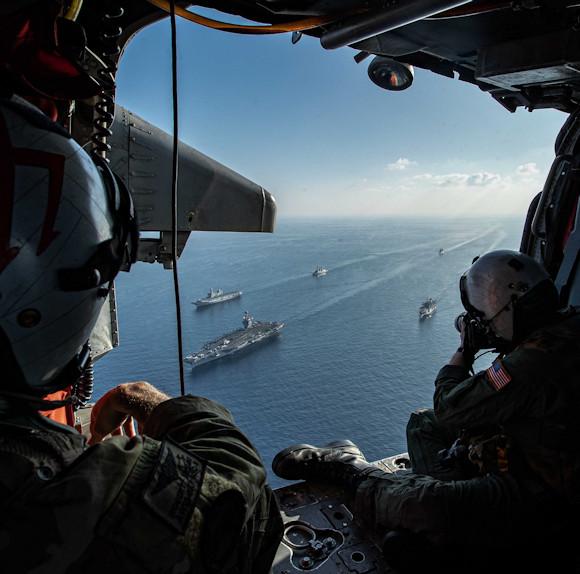The worsening of the Middle Eastern crisis, following the terrorist attack of 7 October 2023, led to the renewal of old frictions that had never really subsided and favored the entry of new (but old) actors into the theater of the Persian Gulf and the Red Sea.
Among the latter, the initiative of the Houthis should be highlighted who, moved by strategic political reasons declared linked to the ongoing conflict in Gaza, have implemented offensive actions in an attempt to selectively hinder commercial maritime transit along the southern Red Sea and Gulf of Aden routes (Anti Access / Denial Area – A2/AD).
In this context, having no Navy, the Houthis do not intervene directly at sea but operate "remotely", using a wide range of drones and anti-ship missiles, both ballistic (Anti Ship Ballistic Missile ASBM, which fall into the category of Short-Range Ballistic Missile SRBM), with an inverted U-shaped flight profile, characterized by a notable steepness of the approach angle to the target and high final speed, both with a traditional trajectory sea skimmer, i.e. with a flight profile that generally brings the missile close to the sea surface, in order to make detection with radar or infrared sensors more difficult, even if radars now have MTI circuits (Moving Target Indication) capable of locating fast approaching targets, even at low altitude.
Maritime operations
In order to hinder the A2/AD strategy of the Houthis, who have aggressively returned to the international scene, the Western world has sent its military ships to patrol those waters and defend an indispensable principle such as that of freedom of navigation (read article "Maritime spaces and international security").
In order to protect merchant traffic in international waters, therefore, Western navies are currently engaged in two different maritime operations.
The Operation Prosperity Guardian is aimed at increasing the presence and surveillance in the area, sees the participation of a coalition of air and naval forces organized by the United States and is structured as Task Force 153, based in Bahrain. Since last April 3rd it has been under Italian command.
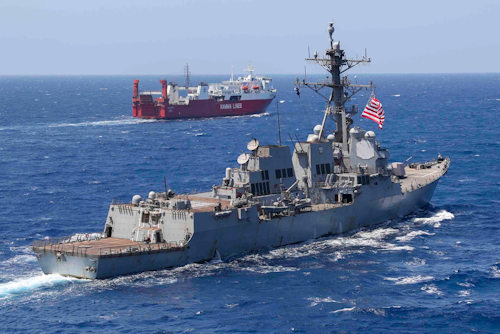
Another ongoing activity is Operation Eunavfor Aspides, led by the EU, whose mission is provide defensive support to commercial ships transiting the region, up to close protection. The strategic level command is assigned to Greece, while the operational and tactical command is carried out from aboard one flagship of the Navy and is currently assigned to Italy.
In this context, the capabilities of command, coordination and control, insured by aircraft carriers or others capital ships, are essential to ensure the effectiveness of maritime operations and the safety of naval groups operating in waters far from national territory. In fact, these are units that are capable of hosting a complex command, that have considerable logistical autonomy, that possess developed defensive and offensive capabilities and that offer standards of habitability that allow them to remain on task for a long time (read article “Importance of the aircraft carrier in a modern Navy").
Finally, the Operation should be remembered Poseidon Archer, an activity conducted by the United States with the support of the United Kingdom, which aims to neutralize the threat through targeted attacks against missile sites and drone launch bases, directly on Houthi-controlled Yemeni territory.
Given that the threat is represented by the extensive use of aerial drones and missiles, the doubt could arise whether these means, significantly faster than a military ship, could expose offshore units (and in particular capital ships) at a higher level of risk. Underlining that zero danger does not exist in any operational activity at sea, it should also be highlighted that naval groups have developed numerous defense tools to render any missile attacks ineffective.
The defense capabilities of the naval group
The most basic protection measure is the maneuver. Operating remotely, in fact, missiles launched against a naval target take time to reach the area. This allows surveillance systems to promptly give the alarm and, therefore, allows the unit or naval group to change the elements of motion, "forcing" the missile's navigation system to recalculate the trajectory. This takes more or less time depending on the technological development of the equipment mounted on the weapon.
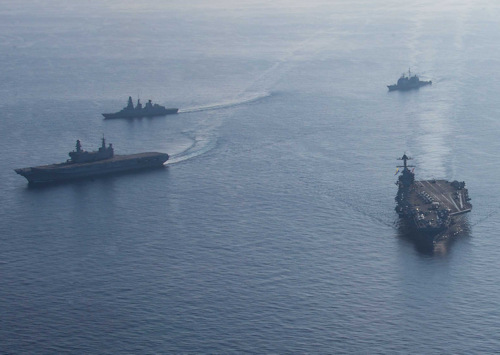
ASBMs, while representing an evolution compared to previous carriers designed to hit surface targets, are nevertheless weapons that have some difficulties to hit a moving target.
Furthermore, a continuous change of course and speed is particularly effective against those missiles that do not have the availability of active guidance or which, for various reasons, in the final phase of the flight profile rely solely on data from the inertial platform . These, in fact, will head towards a point which is the result of the last known detection of the target before the "blind" phase and therefore, if the unit has changed position, they will have little chance of reaching the objective.
Hypersonic missiles are also "blind" in the final phase of flight, as the high speed causes an ionization of the air in front of the nose cone, creating a sort of shield that prevents the missile's active sensors from updating the target's position. Consequently, while against static and large targets (such as land infrastructures) these missiles are deadly, they appear to have significant critical issues against targets pinpoint and capable of maneuvering quickly moving at considerable speeds. It should also be considered that even in the case of the availability of a sensor external to the missile (satellite, support ship, ground radar station) capable of providing the new elements of the target's motion, with the speeds involved it is very difficult to carry out significant variations of the flight profile during the final phase. Paradoxical as it may seem, therefore, the oldest and least technological defensive measure is still effective even in a multi-domain context and against technologically advanced threats.
Similar considerations apply to actions conducted with aerial drones for which, however, one must be highlighted lower lethality with a greater probability of hitting, in relation to the ways in which targets are identified and assigned to aircraft. On some occasions the Houthis appear to exploit AIS data (Automatic Identification System) reported by the merchant ships themselves for the safety of navigation while, in others, any capabilities are used home of drones, as well as reporting by third-party units that are in the area, including surface drones equipped with explosives and various sensors, starting with the optoelectronic ones.
But defensive anti-missile measures are not limited to variations in motion. In fact, ships are also equipped with the best technological solutions available and are, therefore, able to effectively counter a range of possible multidimensional threats.
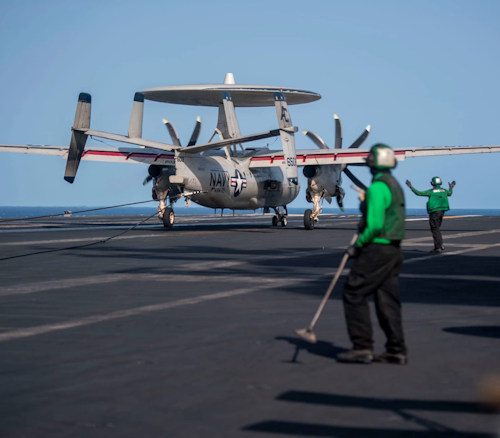 In this context, i on-board surveillance systems on Western naval units participating, for example, in operations in the Red Sea, they also make use of capacity early warning of the aircraft embarked on the aircraft carrier Eisenhower, present in the theater, and have the support of satellite warning systems, which warn of the launch of missiles from the Yemeni coast. Military ships can also make use of deception systems and electromagnetic disturbance with which they are equipped and which range from electronic devices to rockets for the launch of the so-called chaffs.
In this context, i on-board surveillance systems on Western naval units participating, for example, in operations in the Red Sea, they also make use of capacity early warning of the aircraft embarked on the aircraft carrier Eisenhower, present in the theater, and have the support of satellite warning systems, which warn of the launch of missiles from the Yemeni coast. Military ships can also make use of deception systems and electromagnetic disturbance with which they are equipped and which range from electronic devices to rockets for the launch of the so-called chaffs.
The whole set of these systems has proven to be extremely effective in allowing the profitable use of edge weapons in area and point defense from Houthi air and missile threats.
In fact, on several occasions, the weapon systems of Western military units have shot down drones and missiles using a combination of surface-to-air missiles, mostly Standard (USA built) o Aster Europeans (to a lesser extent), and artillery fire (only against drones). Among the methods of neutralizing the threat is also the use of embarked aircraft, mainly airplanes but in certain circumstances also helicopters, always under the timely guidance of team control systems on board, and thanks to the information obtained from the sensors and the various on-board data sharing systems, which also make coordination effective between the different Task Forces.
In essence, despite over 170 attacks recorded so far with six different types of ASBM missiles, in the few cases in which the ballistic missile (or the aerial drone) was not destroyed in flight, impacts in water were mainly recorded and only on a few occasions merchant ships were hit, which were not under close protection and notoriously not designed for navigation with the maneuverability and reactivity profiles typical of military ships.
The effectiveness of military units in protecting against threats brought by drones and missiles in the Red Sea and the Gulf of Aden, some of which are hypersonic, constitutes a significant result that testifies to years of work by the Navies in the study of anti-aircraft and anti-missile warfare, which today converges into a single named field Integrated Air Missile Defense (IAMD) which, in the particular operational theatre, also finds effective application in devices operating at protection of merchant shipping and, therefore, to protect national interests.
final Thoughts
The ongoing situation in the Red Sea, on the one hand, generates confidence in the possibility of self-defense capital ships, fundamental for the exercise of maritime power in a multi-domain perspective, it is also an incentive to continue the capacitive development through sensors and actuators that allow us to continue improving the air and anti-missile defense capabilities of the Navies.
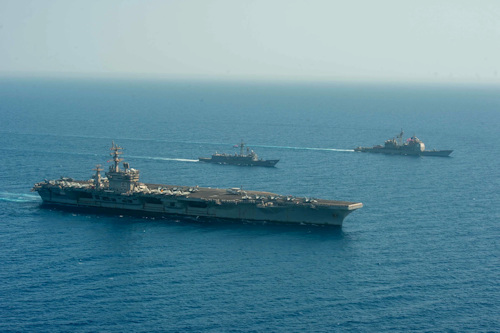 Particular attention is being paid to the topic by the US Navy, with the development of the AEGIS family of integrated combat systems for naval units for the new "Arleigh Burke" class ships and, in the European field, with new sensors and updated versions of the aforementioned missiles Aster.
Particular attention is being paid to the topic by the US Navy, with the development of the AEGIS family of integrated combat systems for naval units for the new "Arleigh Burke" class ships and, in the European field, with new sensors and updated versions of the aforementioned missiles Aster.
The goal is to have capacity of soft-hard kill integrated and suitable to cover all sectors of IAMD, from the fight against ballistic and hypersonic threats to that of cruise missiles and all other types of anti-ship weapons, including drones.
All in an extremely fluid and therefore rapidly evolving geopolitical and geostrategic context, where international tensions from the Mediterranean region to the Indo-Pacific require the coherent development of military projection capabilities, which are found in aero-maritime instrument a crucial element both for the effects it can generate and for the enabling contribution towards the entire military apparatus.
Future crises will develop mainly on the sea, from the sea, above and below the sea and it is in this particular multidimensional operational environment that they will have to be countered, promptly providing adequate tools to those responsible for carrying out this mission. And, together with underwater, naval aviation and space capabilities, the larger units will represent theessence of the presence of the State on international theaters.
In this context the capital ships they therefore retain all theirs strategic significance. Far from being a weakness they are, instead, a strength to effectively protect national economic and political interests and they will be the nucleus that will allow the coordinated and effective conduct of future maritime operations anywhere in the world, whether for the protection of merchant traffic or the projection of power, in order to render attacks against maritime commercial traffic ineffective. Not understanding this fact means dwelling on the detail of a painting while losing sight of the whole (read article "The protection of national interests on the sea").
Even if large naval clashes similar to those of the Second World War are no longer foreseeable, there is no doubt that the navies play and will continue to play a fundamental political-military and economic role in guaranteeing freedom of navigation on the seas of the world and in protecting the interests vital and prestige of their country. And the capital ships are, and will continue to be in the future, an indispensable component for allow a modern Navy to be able to effectively carry out its mission (read article "The need for a smart national maritime strategy").
It is, therefore, the task of political decision makers to promptly develop policies and planning that take into account the evolution of the threat in maritime scenarios and with a vision that goes beyond the simplistic backyard fence, without giving credence to those sirens who sing children's songs. cabotage and very limited range. In essence, look beyond the horizon without being seduced by comfortable but misleading minimalist theories lacking logical, historical and operational support.
What Italy will be and how much it will be able to protect its prestige and its national interests must be decided with a vision that is neither distorted nor ideological, but keeping in mind the national economic and political interests which, today and tomorrow, affect all the seas of the world . Turning a blind eye doesn't solve problems and allows the threat to grow and thrive.
Photo: US Navy

